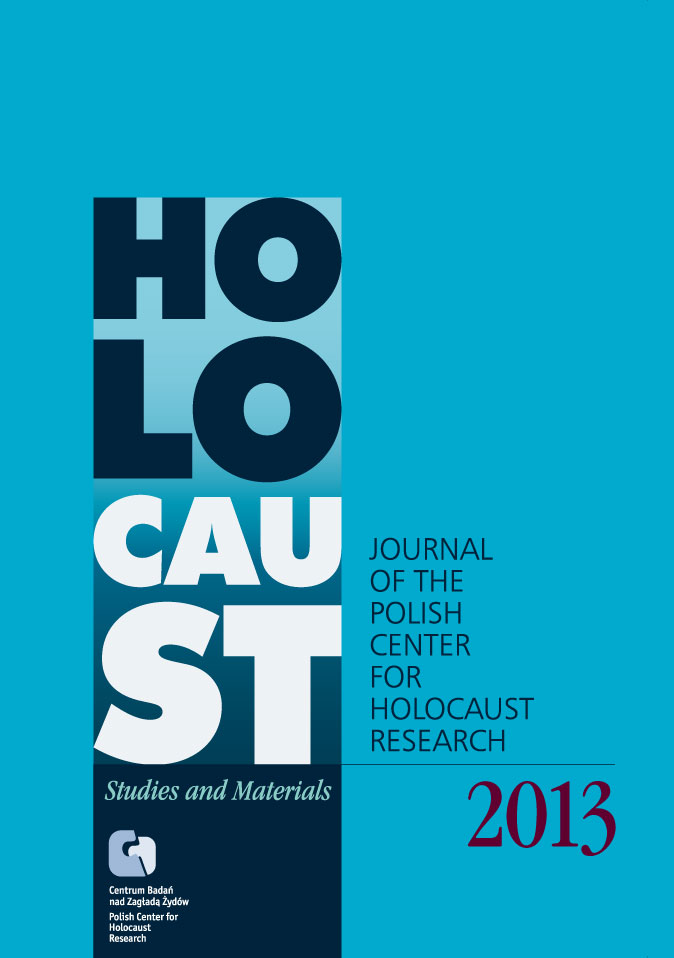Gone but not Forgotten: Archaeological approaches to the site of the former Treblinka Extermination Camp in Poland
Zagłada Żydów. Studia i Materiały, Nr Holocaust Studies and Materials (2013), Strony: 253-289
Data zgłoszenia: 2020-12-13Data publikacji: 2013-02-20
 https://doi.org/10.32927/zzsim.809
https://doi.org/10.32927/zzsim.809
Abstrakt
Public impression of the Holocaust is unquestionably centred on knowledge about, and the image of, Auschwitz-Birkenau – the gas chambers, the crematoria, the systematic and industrialized killing of victims. Conversely, knowledge of the former extermination camp at Treblinka, which stands in stark contrast in terms of the visible evidence that survives pertaining to it, is less embedded in general public consciousness. As this paper argues, the contrasting level of knowledge about Auschwitz-Birkenau and Treblinka is centred upon the belief that physical evidence of the camps only survives when it is visible and above-ground. The perception of Treblinka as having been “destroyed” by the Nazis, and the belief that the bodies of all of the victims were cremated without trace, has resulted in a lack of investigation aimed at answering questions about the extent and nature of the camp, and the locations of mass graves and cremation pits. This paper discusses the evidence that demonstrates that traces of the camp do survive. It outlines how archival research and non-invasive archaeological survey has been used to re-evaluate the physical evidence pertaining to Treblinka in a way that respects Jewish Halacha Law. As well as facilitating spatial and temporal analysis of the former extermination camp, this survey has also revealed information about the cultural memory associated with the site and how much has been forgotten about its history.
Licencja
Prawa autorskie (c) 2013 Autor & "Zagłada Żydów. Studia i Materiały"

Utwór dostępny jest na licencji Creative Commons Uznanie autorstwa 4.0 Międzynarodowe.
https://creativecommons.org/licenses/by/4.0
Inne teksty tego samego autora
- Caroline Sturdy Colls, O tym, co minęło, lecz nie zostało zapomniane: Badania archeologiczne na terenie byłego obozu zagłady w Treblince , Zagłada Żydów. Studia i Materiały: Nr 8 (2012)
Podobne artykuły
- Jerzy Tomaszewski, Jakub Petelewicz, Jak Polacy patrzyli na getto z zewnątrz z Jerzym Tomaszewskim rozmawia Jakub Petelewicz , Zagłada Żydów. Studia i Materiały: Nr 1 (2005)
- Israel Gutman, Barbara Engelking, O tym jak z wewnątrz warszawskiego getta patrzono na stronę aryjską z profesorem Izraelem Gurmanem rozmawia Barbara Engelking , Zagłada Żydów. Studia i Materiały: Nr 1 (2005)
- Jacek Leociak, Nie chcę ludziom na śmiech się pokazać, że Żydów u siebie chowałem...Sprawa Zdzisława i Haliny Krzyczkowskich , Zagłada Żydów. Studia i Materiały: Nr 4 (2008)
- Dariusz Libionka, Jan Grabowski, Meldunki Obwodu „Praga” Policji Polskiej o zatrzymaniach Żydów w Warszawie w okresie maj–lipiec 1943 r. , Zagłada Żydów. Studia i Materiały: Nr 10 (2014)
- Jan Grabowski, Tadeusz Tomasz Krasnodębski, Policjant konspiratorem. Szesnaście lat na muszce Gestapo i bezpieki [Policeman-Conspirator. Sixteen years on a sight of Gestapo and State Security] , Zagłada Żydów. Studia i Materiały: 2010: Holocaust Studies and Materials
- Barbara Engelking, „Niemcy zabili nam Żydów, więc wyrzucamy”. Sprawa Edwarda Toniakiewicza , Zagłada Żydów. Studia i Materiały: Nr 10 (2014)
- Piotr Forecki, Kwietniowe gadanie. Polskie flagi nad gettem , Zagłada Żydów. Studia i Materiały: Nr 10 (2014)
- Havi Dreifuss, Utajone miasta. Kilka uwag o metodologii Gunnara S. Paulssona , Zagłada Żydów. Studia i Materiały: Nr 10 (2014)
- Michał Głowiński, Oczy donosiciela , Zagłada Żydów. Studia i Materiały: Nr 10 (2014)
- Przemysław Czapliński, Wirus Auschwitz , Zagłada Żydów. Studia i Materiały: Nr 10 (2014)
<< < 25 26 27 28 29 30 31 32 33 34 35 36 37 38 39 40 41 42 43 44 45 46 47 48 49 50 51 52 53 54 55 56 57 58 59 60 61 62 63 64 65 66 67 68 69 70 71 > >>
Możesz również Rozpocznij zaawansowane wyszukiwanie podobieństw dla tego artykułu.
 English
English
 Język Polski
Język Polski








